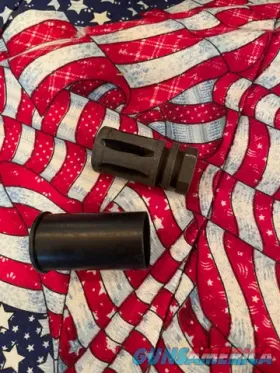
Estimated reading time: 7 minutes
This is a trick question. An AR-15 and its big brother the AR-10 use a gas system that is more often than not referred to as a direct impingement system, but they do not use a true direct impingement system. The AR-15 system does have similar components to a direct impingement system. It also has a piston built into the bolt carrier group or BCG. So now I’ve thoroughly confused you and caused you to scratch your head, rethinking everything. From man’s existence on earth to how Twinkies are made. Let’s take a quick look at how an AR-15 and AR-10 operate.
Table of contents
How Does An AR-15 Operate?
The gas system in any AR-15 is chambered in .223 Remington or 5.56x54mm NATO or a similar-sized cartridge. An AR-10 is chambered in .308 Winchester or 7.62x51mm NATO or similar-sized cartridge. Both use high-pressure gas from a fired cartridge to cycle the action.
Available on GunsAmerica Now

When you fire a shot, a port or tiny hole in the top of the barrel vents gas upward through the gas block and into a gas tube. The gas tube runs along the top of the barrel back toward the action and into the upper receiver where it mates up with the gas key on the top of the BCG.
The gas flows through the gas key and into an expansion chamber in the rear front portion of the BCG and the rear of the bolt. These are essentially the two parts of the piston: the expansion chamber in the BCG acts like a cylinder and the bolt acts like a piston. Are those sealing rings on the end of the bolt making sense now? They act as piston rings. That is why you don’t line up the gaps in the three rings on the bolt after cleaning it.
What Happens In That Chamber
The gas expands in the chamber forcing the BCG rearward while the bolt is locked into the rear of the barrel. As the BCG moves rearward the cam pin is engaged to rotate the bolt and unlock it from the barrel so both the BCG and bolt continue rearward. You may have noticed gas puffing out of the two expansion holes in the side of the BCG. That is the gas being vented from the expansion chamber in the BCG.
The BCG continues rearward, the cartridge case is extracted and ejected, the hammer is cocked and the trigger is reset. The action spring in the receiver extension or buffer tube then pushes the BCG back to chamber a cartridge and the bolt rotates back in place locking the cartridge in the chamber.
Technically the AR-15 and AR-10 do not use a direct impingement system, but a gas system with a rotating bolt and a modified piston. Eugene Stoner described the AR-15 operating system as an expanding gas system instead of the conventional impinging gas system. Most people still refer to it as a direct impingement system, so feel free to smile when they say that knowing it isn’t and let them eat their Twinkie.
Pistol caliber AR-15s are a different animal and use a blowback system. I’ll save that for another time.
What Is A Piston System AR-15?
Rifles that use a piston system have been around for decades. The M1 Garand, M1 Carbine, and M14—the Mini-14, too—all use a piston operating system. The AK-47 and its derivatives also use a piston system. These rifles are further segmented into short-stroke piston or stroke piston systems. They all operate similarly. Instead of the burning gases flowing into a gas tube, the gas flows directly into a cylinder.
In the case of an AK-47, which is a long-stroke piston system, gases are ported into the cylinder above the barrel. The gases then push the piston, which is connected to the bolt carrier, rearward to cycle the gun. Piston system AR-15 rifles use a similar system.

In a piston system AR-15, a cylinder above the barrel is fed burning gases from a port in the barrel to push against the piston and rod located inside the cylinder. The piston and rod move rearward to operate the BCG. Instead of a gas key on the top of the BCG, there is a lug that the piston rod pushes against.
Pros And Cons of Gas vs. Piston AR-15s
Both gas and piston systems use gas to unlock the bolt and cycle the BCG. Is one system better than the other? It depends. There are pros and cons to both systems.
Gas systems have a lot of history and real-world use on its side. In the Pro column gas systems are lightweight. They produce less recoil because the BCG is pushed rearward with less force. Lastly, they are more accurate. ARs with a gas system are also less expensive than piston system ARs because they use plentiful mil-spec parts. Gas AR-15s are typically lighter than piston AR-15s. In the Cons column, the gas tube pukes burning gases into the BCG which requires diligent cleaning if you want your AR to go bang every time you press the trigger.
In the Pro column for piston systems, they are more reliable. The BCG stays much cleaner and cooler. The rifle is typically less finicky about ammo. The cons are that piston system ARs are less accurate than direct impingement ARs because the piston system interferes with the barrel harmonics and movement. Not to mention they have more moving parts. The piston also creates more felt recoil, and the AR is typically heavier. Piston system guns are usually more expensive.
Experts On The Pros and Cons
Many experienced shooters look at the Pros and Cons this way: Rifle- and Mid-length gas systems work best, but carbine and shorter rifles are best suited to a piston system. That’s why some special ops personnel like Navy SEALs, Delta Force, and others have used the HK416. The Heckler & Koch HK416 is based on the M4 gas system gun but uses a short-stroke piston system.
Adams Arms, LWRC, H&K, POF-USA, and others manufacture piston-system AR-15 rifles. You can also convert a gas system AR-15 with a kit from Superlative Arms and Adams Arms. Complete mil-spec uppers are also available that will work with a mil-spec lower.
READ MORE: Pump Action Shotguns – The All-Time Greats
I have an old Ruger SR-556 Takedown that is a piston system AR and the recoil is snapper compared to a similar gas system operated AR. It is my go-to AR15 for hunting deer and pigs. Gas system ARs run more smoothly. Most of us have experience with gas system ARs. Shooting a piston system AR15 should be on your bucket list and then it will probably move to your wish list.
What’s AR15 System Is Better: Gas Or Piston?
I’ve used both with good success and my suggestion is both. Life is too short to have only one upper for your AR.
*** Buy and Sell on GunsAmerica! ***












Is the third option, RDB, being ignored here?
CMMG’s AR bolt management system also needs to be taken into context – please —
What kind or stupid crap is this? Who writes this Rube Goldberg nonsense? Oh, the AR15 has a muzzle loader component too! Every bullet goes into the muzzle of the cartridge case! Damn. Drop dead.
WOW! Chill bro!